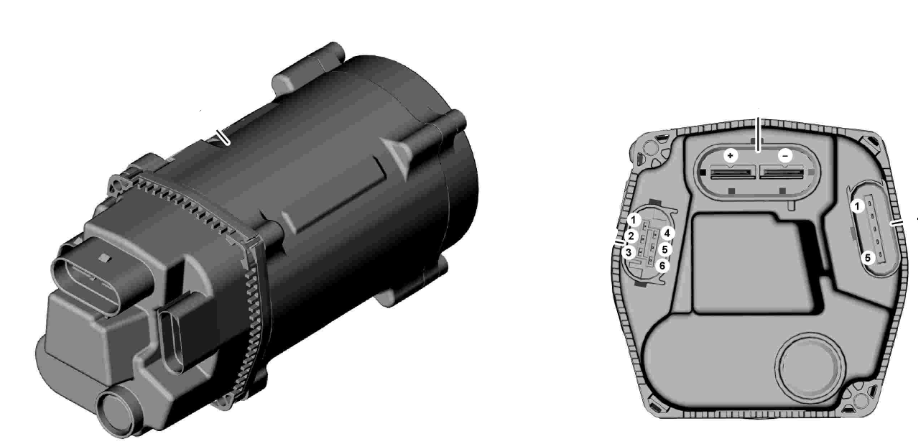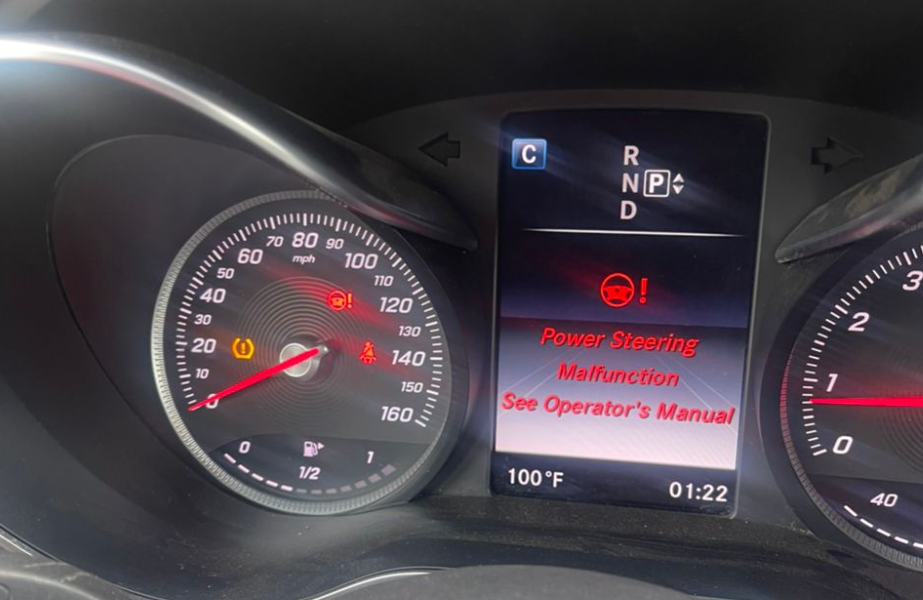Table of Contents
Power Steering Malfunction See Operator’s Manual
When your Mercedes displays “Power Steering Malfunction See Operator’s Manual”, it means the Electric Power Steering (EPS) system has detected a fault and disabled power assistance. You can still steer the vehicle, but the wheel will feel extremely heavy especially at low speeds and the issue requires immediate attention.
Electrical steering issues are part of a broader range of Mercedes electrical faults, including SAM module failures, CAN Bus interruptions, low-voltage problems, and control unit malfunctions. For a deeper understanding of these interconnected issues, see our full guide here:
Explore Full Diagnostics: Mercedes Electrical Problems – Fix SAM, ECU & CAN Bus Faults
Modern Mercedes models (W205, W213, W222, W176, W204 late models) rely completely on electronically assisted steering. That means even a minor voltage drop, CAN communication failure, or overheating condition can disable EPS instantly.
This guide explains the causes, symptoms, and diagnostic steps, and includes a detailed case study on a Mercedes C300 to help technicians and owners resolve this failure correctly.

What “Power Steering Malfunction” Means in a Mercedes
This warning indicates the EPS system has shut down due to a fault involving:
- – The electric power steering motor
- – Steering angle and torque sensors
- – CAN Bus or FlexRay communication
- – EPS control module
- – Low-voltage or alternator issues
- – Overheating of the steering motor or ECU
- – Faulty ground points or high-resistance wiring
If EPS assistance is lost, steering becomes manual. On heavy Mercedes models, this can feel extremely stiff and unsafe.
Case Study: Power Steering Malfunction Mercedes C300
A Mercedes C300 owner reported stiff steering and a “Power Steering Malfunction” message on the display. Steering assist was lost intermittently before failing completely.

Step 1 : Initial Diagnostics
A Mercedes technician performed a scan using STAR/XENTRY, revealing:
- P0635 – Power Steering Control Circuit
- P063500 – Steering Control Overheating
These faults immediately suggested:
- – Current overload
- – EPS motor overheating
- – Possible internal pump damage
- – Communication fault in FlexRay or CAN
Step 2 : Electrical Testing
The technician:
- – Verified voltage supply at the EPS control unit
- – Checked ground resistance
- – Tested CAN Bus and FlexRay continuity using a multimeter
- – Inspected connectors for moisture or corrosion
Results confirmed:
The electric power steering pump (motor) was damaged.

Step 3 : Component Replacement
The EPS motor/pump was replaced. After installation:
- – The system was re-initialized
- – Fault codes were cleared
- – A test drive confirmed full steering assist without overheating
This case highlights how EPS faults are often tied to electrical failures not mechanical issues which is why correct electronic diagnosis is essential.
Symptoms of a Failing Mercedes Power Steering System
Common warning signs include:
1. Whining / Squealing Noise
Often heard when turning the steering wheel.
2. Hard or Heavy Steering
Especially noticeable at low speed or during parking.
3. Jerky or Intermittent Assist
Power assist comes and goes, especially after driving for a few minutes.
4. Overheating Symptoms
EPS shuts down temporarily; assist returns after cooling.
5. Communication Errors
CAN errors linked to EPS, powertrain, or chassis systems.

Common Causes & How to Diagnose Them
| Cause | Symptoms | How to Diagnose |
|---|---|---|
| Weak Battery / Alternator Voltage Drop | Heavy steering, multiple warnings | Measure battery voltage (>12.4V), alternator output (13.5–14.8V) |
| Blown EPS Fuse (125A pre-fuse) | Sudden EPS loss | Inspect pre-fuse box in engine bay |
| Faulty Steering Motor/Rack | Persistent warning, DTC P0635 | Scan EPS module; check overheating data |
| Corroded Ground or Wiring | Intermittent assist | Inspect ground strap & connectors |
| Software Glitch in EPS Module | Assist disappears then returns | Power-cycle & check for SW updates |
| Broken Steering Angle Sensor | ESP, ABS, Steering warnings | STAR/XENTRY steering calibration |
DIY vs Professional Repair
| Task | DIY? | Dealer Needed? |
|---|---|---|
| Test battery & charging | ✔ | Optional |
| Inspect steering fuses | ✔ | No |
| Clean EPS connectors | ✔ (carefully) | Recommended |
| Read basic OBD codes | ✔ | No |
| CAN/FlexRay diagnosis | ✘ | ✔ |
| Replace EPS motor or rack | ✘ | ✔ |
| EPS software/variant coding | ✘ | ✔ |
Preventive Tips to Avoid EPS Failure
- – Maintain battery health (Mercedes EPS is voltage sensitive).
- – Keep ground points clean and tight.
- – Avoid deep water or moisture exposure near the EPS motor.
- – Inspect the 125A pre-fuse annually.
- – Perform regular software updates during service.
Is There a Power Steering Fuse in Mercedes?
Yes, many Mercedes models with EPS have a high-amperage 100–125A pre-fuse located in the engine compartment fuse box.
If this fuse blows, EPS shuts off instantly.
Not all models have a dedicated low-amp fuse; the system is primarily protected by the pre-fuse.
How Does Mercedes Electric Power Steering Work?
EPS uses:
- – A torque sensor
- – Steering angle sensor
- – Electric assist motor
- – EPS control unit
- – CAN & FlexRay communication

The ECU calculates assistance based on:
- – Steering torque input
- – Wheel speed sensors
- – Driver steering speed
- – Engine speed
- – Vehicle speed
EPS improves fuel efficiency, reduces weight, and allows smarter integration with ADAS features.
How to Fix “Power Steering Malfunction” in Mercedes
Here are the essential steps:
1. Check Voltage
Low voltage is the #1 cause of EPS faults.
2. Inspect EPS Fuse
Replace the 125A pre-fuse if blown.
3. Check Connectors & Grounds
EPS wiring is sensitive to corrosion.
4. Scan for Fault Codes
Use XENTRY for full diagnostics.
5. Reset the System
A full power-cycle sometimes clears temporary faults.
6. Replace Faulty Components
EPS motor or steering rack replacement is common on W205 & W213 platforms.
Sudden Power Steering Loss: What You Should Do
If steering suddenly becomes stiff:
- 1. Do not panic the car is still steerable manually.
- 2. Pull over safely.
- 3. Restart the vehicle to attempt a reset.
- 4. Avoid high-speed driving.
- 5. Scan the vehicle ASAP for EPS error codes.
Conclusion
A Power Steering Malfunction warning in your Mercedes is almost always linked to electrical or control unit issues not mechanical ones. Because EPS relies heavily on stable voltage, CAN/FlexRay communication, and accurate sensor data, even a small disruption can disable power assist.
By understanding the causes, symptoms, and diagnostics and learning from the real Mercedes C300 case study you can take the right steps to restore safe steering performance.
For deeper troubleshooting of related electrical, SAM, CAN, and ECU issues, visit our hub:
Mercedes Electrical Problems: Fix SAM, ECU & CAN Bus Faults
— Salim, Mercedes Expert
Independent specialist in Mercedes-Benz diagnostics, CAN Bus analysis, troubleshooting case studies, and EV systems.







Leave a Reply